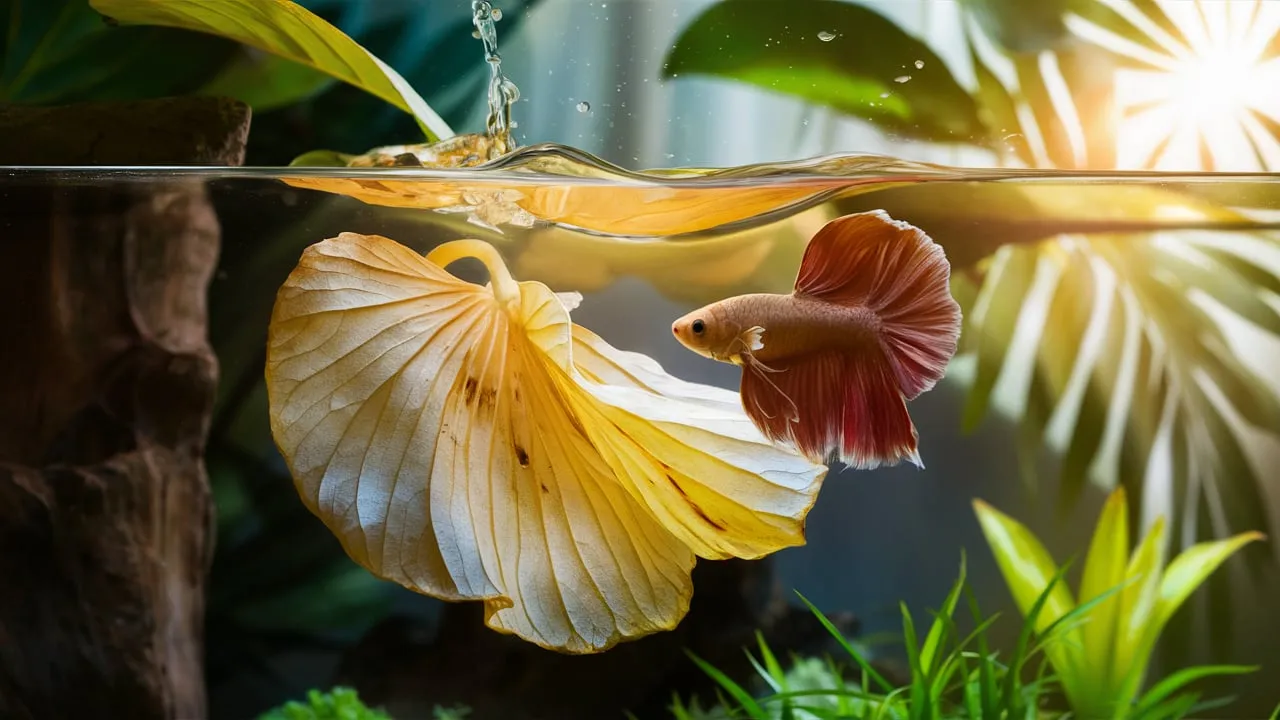Betta fish, often referred to as “Siamese fighting fish,” have captured the hearts of aquarium enthusiasts worldwide. These vibrant, captivating creatures thrive in environments that mimic their natural habitats. One of the most effective ways to create a thriving ecosystem for your betta fish is by incorporating almond leaves into their aquarium. This natural, organic element not only enhances the aesthetic appeal of your betta’s home but also provides a wealth of benefits for their overall health and well-being. In this articl of Betta Fish Tips will explore the benefits of almond leaf for betta fish.

The Benefits of Almond Leaf for Betta Fish
Almond leaves, derived from the Terminalia catappa tree, are a remarkable addition to any betta fish tank. These leaves offer a range of advantages that can contribute to the well-being of your beloved betta:
1. Water Purification
Almond leaves contain tannins, which act as natural water purifiers. As the leaves decompose, they release these tannins into the water, helping to reduce the buildup of harmful compounds and maintain optimal water quality.
2. pH Balancing
The tannins in almond leaves can also help to lower the pH of the water, creating a more acidic environment that mimics the natural habitat of betta fish. This pH balance is crucial for the health and vitality of your betta.
3. Stress Reduction
Bettas are known to be sensitive to their environment, and excessive stress can lead to a variety of health issues. Almond leaves provide a calming, natural element in the aquarium, helping to reduce stress and promote a peaceful, thriving environment for your betta.
4. Immune System Support
The compounds found in almond leaves have been shown to possess anti-fungal and anti-bacterial properties. By introducing these leaves to your betta’s tank, you can help strengthen their immune system and protect them from common diseases.
5. Natural Coloration Enhancement
Almond leaves can also enhance the natural coloration of your betta fish. The tannins released by the leaves can bring out the vibrant hues and patterns of your betta, making them truly stunning to behold.
How to Use Almond Leaves in Your Betta’s Tank
Incorporating almond leaves into your betta’s aquarium is a straightforward process. Here’s a step-by-step guide:
- Prepare the Leaves: Thoroughly rinse the almond leaves under running water to remove any impurities or debris.
- Add the Leaves: Place the clean almond leaves directly into your betta’s tank, ensuring they are fully submerged.
- Monitor the Water: As the leaves decompose, they will release tannins into the water, gradually lowering the pH. Keep a close eye on the water parameters and make adjustments as needed to maintain the optimal environment for your betta.
- Replace the Leaves: Depending on the size of your tank and the number of leaves, you may need to replace them every few weeks to maintain the desired water conditions.
By following these simple steps, you can harness the power of almond leaves to create a thriving, natural habitat for your beloved betta fish.
Frequently Asked Questions
Q: How many almond leaves should I add to my betta’s tank?
A: The number of leaves you add will depend on the size of your tank. As a general rule, start with 1-2 leaves per 2.5 gallons of water and adjust as needed based on the desired water parameters.
Q: How often should I replace the almond leaves?
A: The frequency of leaf replacement will vary depending on the size of your tank and the rate of decomposition. Typically, you’ll need to replace the leaves every 2-4 weeks to maintain the desired water quality.
Q: Can almond leaves be used in combination with other water treatments?
A: Yes, almond leaves can be used in conjunction with other water treatments, such as API Stress Coat or SeaChem Prime, to further enhance the water quality and support your betta’s health.
Q: How do almond leaves affect the breeding of betta fish?
A: Almond leaves, which come from the Indian almond tree (Terminalia catappa), can have several effects on the breeding of betta fish (Betta splendens):
- Water pH and tannins: As almond leaves decompose in the water, they release tannins which can lower the water’s pH, making it more acidic. Bettas generally prefer slightly acidic to neutral water with a pH around 6.5-7.5. The tannins can also darken the water, creating a blackwater effect.
- Spawning stimulation: The tannins and other compounds released by almond leaves are thought to mimic natural blackwater conditions that bettas encounter in the wild. This can help stimulate breeding behaviors and encourage the male betta to build a bubble nest.
- Fry development: The tannins and reduced pH can also benefit betta fry by inhibiting the growth of fungus and bacteria. This can improve survival rates of the young betta fish.
- Stress reduction: The calming effects of the tannins may help reduce stress in the adult bettas during the breeding process, leading to more successful spawnings.
However, it’s important to use almond leaves in moderation, as too many tannins can also be detrimental. Careful monitoring of water parameters is recommended when using almond leaves in a betta breeding setup. The optimal amount will depend on the size of the aquarium and the specific needs of the bettas.
Conclution
By incorporating almond leaves into your betta’s aquarium, you’ll be providing a natural, beneficial environment that supports their overall well-being. Enjoy watching your betta thrive and showcase their vibrant colors in a habitat that closely mimics their natural surroundings.

Bài viết liên quan
How Many Female Bettas In A 10 Gallon Tank?
Betta fish, also known as Siamese fighting fish, are a popular choice for aquarium enthusiasts [...]
Jul
Understanding Healthy Betta Fish Habitat
Betta fish, also known as Siamese fighting fish, are a popular choice for many aquarium [...]
Jul
What Is Fighting Fish Fin Rot?
Betta fish, also known as Siamese fighting fish, are a popular choice for aquarium enthusiasts. [...]
Jul